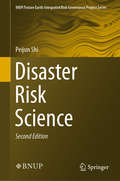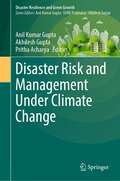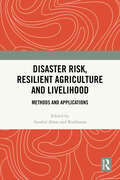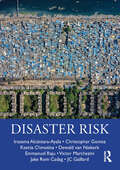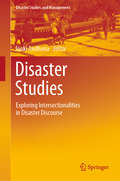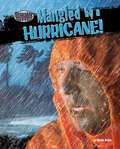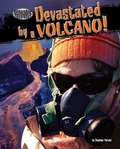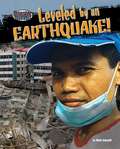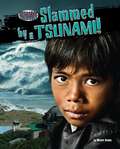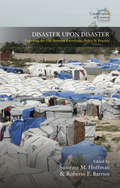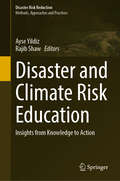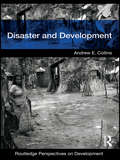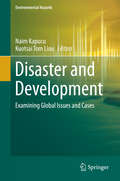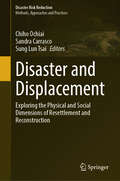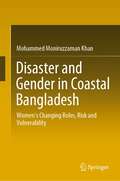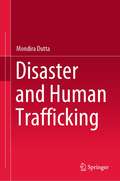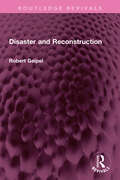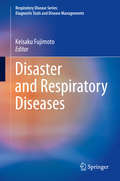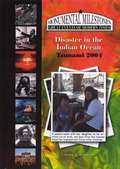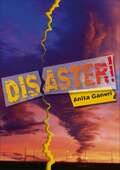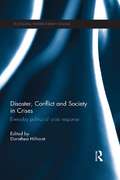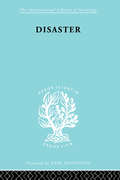- Table View
- List View
Disaster Risk Science: Science Plan And Case Studies Of Large-scale Disasters (IHDP/Future Earth-Integrated Risk Governance Project Series)
by Peijun ShiThis is the first English language book to systematically introduce basic theories, methods and applications of disaster risk science from the angle of different subjects including disaster science, emergency technology and risk management. Viewed from basic theories, disaster risk science consists of disaster system, formation mechanism and process, covering 3 chapters in this book. From the perspective of technical methods, disaster risk science includes measurement and assessment of disasters, mapping and zoning of disaster risk, covering 4 chapters in this book. From the angle of application practices, disaster risk science contains disaster management, emergency response and integrated disaster risk paradigm, covering 3 chapters in the book. The book can be a good reference for researchers, students, and practitioners in the field of disaster risk science and natural disaster risk management for more actively participating in and supporting the development of "disaster risk science".
Disaster Risk and Management Under Climate Change (Disaster Resilience and Green Growth)
by Anil Kumar Gupta Akhilesh Gupta Pritha AcharyaThis contributed volume is focused on SDG 3, 6, 7 ,9, 11, 15, and it covers extensive knowledge on damage and loss contexts of climate change in a developing country. India’s vast landscape with its diversity of eco-geo-physiography, socio-cultural, and developmental settings, coupled with climate change and anthropogenic factors, makes it one of the most disaster-prone countries of the world and, thus, representing almost all the disasters and extreme events associated with climate change, variability, and weather phenomenon. Besides common hazards,such as heavy rainfall, floods, drought, cyclone and heat wave, secondary and composite disasters like forest fires and disease epidemics are also covered with case studies and examples. Cross-cutting aspects like infrastructure resilience, gender and social equity concerns, legal and assessment tools, and futuristic vision have been covered well in the book. Disaster risk reduction, preparedness, and resilience as central themes of adaptation to climate change are presented through policy discussions, tools, and strategic analysis of past and recent lessons. This book is of common interest to a wider range of readers across policyplanning, academia, research, and professional practitioners having interest in adaptation, resilience building and sustainability in developing countries of the world. Though it is primarily a reference book, it can also serve as a textbook for university courses and professional trainings in climate change adaptation, disaster management, sustainability and strategic management studies.
Disaster Risk, Resilient Agriculture and Livelihood: Methods and Applications
by Asraful AlamThis volume discusses important issues associated with agricultural disaster risk, resilient agriculture, and livelihood. It highlights the role of sustainable development goals in reducing the impact of climate change on agriculture. The contributions found in this volume discuss methodological and innovative resilience approaches to various natural hazards including flood, landslide, environmental challenges, strategies of disaster risk management, livelihood, ecosystem services, and agricultural sustainability. It explores the relationship between climatic change and agricultural transformation. While throwing light on the role of ecosystem services in disaster risk reduction, the book explores the impact of land degradation and change on growth of agricultural production and food production. The book will be useful for students and researchers of geography, environmental sciences, disaster management, and environmental geology. It will also be useful for geographers, environmentalists, hydrologists, geomorphologists, planners, and professionals working on related ideas.
Disaster Risk: International Lessons In Risk Reduction, Response And Recovery
by Irasema Alcántara-Ayala Ksenia Chmutina JC Gaillard Christopher Gomez Dewald van Niekerk Emmanuel Raju Victor Marchezini Jake Rom CadagThe text offers a comprehensive and unique perspective on disaster risk associated with natural hazards. It covers a wide range of topics, reflecting the most recent debates but also older and pioneering discussions in the academic field of disaster studies as well as in the policy and practical areas of disaster risk reduction (DRR). This book will be of particular interest to undergraduate students studying geography and environmental studies/science. It will also be of relevance to students/professionals from a wide range of social and physical science disciplines, including public health and public policy, sociology, anthropology, political science and geology.
Disaster Studies: Exploring Intersectionalities in Disaster Discourse (Disaster Studies and Management)
by Janki AndhariaThis book covers several dimensions of disaster studies as an emerging discipline. It is the inaugural book in the series ‘Disaster Studies and Management’ and deals with questions such as “Is disaster management a field of practice, a profession, or simply a new area of study?” Exploring intersectionalities, the book also examines areas of research that could help enhance the discourse on disaster management from policy and practice perspectives, revisiting conventional event-centric approaches, which are the basis for most writings on the subject. Several case studies and comparative analyses reflect a critical reading of research and practice concerning disasters and their management. The book offers valuable insights into various subjects including the challenge of establishing inter- and multi-disciplinary teams within the academia involved in disaster studies, and sociological and anthropological readings of post-disaster memoryscapes. Each of the contributors has an enduring interest in disaster studies, thus enriching the book immensely. This book will be of interest to all the students and scholars of disaster studies and disaster management, as well as to practitioners and policymakers.
Disaster Survivors Mangled By A Hurricane!
by Miriam AroninOn August 28, 2005, Trina Peters heard some alarming news -Hurricane Katrina was headed straight for her hometown of New Orleans, Louisiana. Though officials recommended evacuating the city, Trina and her daughter decided to stay in their home. However, the powerful hurricane caused their house to flood, and they had to climb up on their roof to stay above the rising water. Stranded on the roof in roaring winds and pouring rain, could Trina and her daughter survive the storm? Eyewitness accounts and incredible photos bring to life the experiences of ordinary people who faced catastrophic danger and lived to tell their stories. Kids will discover the causes and characteristics of hurricanes, and learn about efforts to rebuild and prepare for future storms. Safety tips show young readers what to do in case a hurricane strikes.
Disaster Survivors: Devastated by a VOLCANO!
by Stephen PersonOn June 25, 1997, a volcano on the Caribbean island of Montserrat erupted, spewing hot lava and ash. Linda Daley was washing clothes outside her home in the nearby city of Plymouth when she saw fiery clouds begin to shoot out of the volcano. With clouds of ash and poisonous gases speeding toward her, how would she survive? Eyewitness accounts and incredible photos bring to life the experiences of ordinary people who faced catastrophic danger and lived to tell their stories. Kids will discover the causes and characteristics of volcanoes, and learn about the scientific advances that now allow earlier warnings of possible eruptions to be issued. Safety tips show young readers what to do if they are ever near a volcanic eruption.
Disaster Survivors: Hammered By A Heat Wave!
by Laura DelalloIn July 1995, a scorching heat wave blasted Chicago with temperatures as high as 106° F (41° C) for five days straight. Such extreme weather can cause heat stroke and even death in vulnerable individuals; in fact, heat waves kill more people in the United States each year than any other kind of natural disaster. How would residents of Chicago survive the relentless heat? Eyewitness accounts and incredible photos bring to life the experiences of ordinary people who faced catastrophic danger -and lived to tell their stories. Kids will discover the causes and characteristics of heat waves and find out how hot weather can quickly turn deadly. Safety tips show young readers how to stay cool during a heat wave.
Disaster Survivors: Leveled By An Earthquake!
by Adam ReingoldOn May 12, 2008, a strong earthquake rocked Beichuan, China, destroying buildings and entire neighborhoods. When Beichuan's high school collapsed, 16-year-old Li Anning and her friends were trapped under the heavy rubble. Could the students survive until rescue workers arrived to save them? Eyewitness accounts and incredible photos bring to life the experiences of ordinary people who faced catastrophic danger -and lived to tell their stories. Kids will discover the causes and characteristics of earthquakes and learn about scientific advances that now help new buildings withstand the force of an earthquake. Safety tips show young readers what to do in case an earthquake occurs.
Disaster Survivors: Slammed By A Tsunami!
by Miriam AroninOn December 26, 2004, carpenter Ari Afrizal was helping build a house on the Indonesian island of Sumatra. Suddenly, he heard a loud whooshing sound and saw a wall of water heading directly toward him. The huge wave was a tsunami that destroyed the house he was working on and swept him out to sea. Alone in the ocean, Ari struggled to survive. Against all odds, would he live through this horrible ordeal? Eyewitness accounts and incredible photos bring to life the experiences of ordinary people who faced catastrophic danger -and lived to tell their stories. Kids will discover the causes and characteristics of tsunamis, and learn about scientific advances in warning systems. Safety tips show young readers what to do in case a tsunami occurs.
Disaster Survivors: Struck By Lightning!
by Stephen PersonOn July 26, 2003, mountain-climber Rod Liberal was nearing the summit of Grand Teton Mountain in Wyoming. As Rod clung to the side of a granite cliff, he saw dark clouds rolling toward him. Suddenly, there was a burst of light as a bolt of lightning struck his chest and blew him off the mountain. Attached to the cliff by a rope, he swung in the air thousands of feet above the ground. Would Rod be able to hold on until rescue rangers arrived to save him? Eyewitness accounts and incredible photos bring to life the experiences of ordinary people who faced catastrophic danger -and lived to tell their stories. Kids will discover the causes and characteristics of lightning strikes, and learn about scientific advances in weather forecasting and safety precautions. Safety tips show young readers what to do in case they're caught in a thunderstorm.
Disaster Upon Disaster: Exploring the Gap Between Knowledge, Policy and Practice (Catastrophes in Context #2)
by Roberto E. Barrios Susanna M. HoffmanA consistent problem that confronts disaster reduction is the disjunction between academic and expert knowledge and policies and practices of agencies mandated to deal with the concern. Although a great deal of knowledge has been acquired regarding many aspects of the gap, such as driving factors, risk construction, complexity of resettlement, and importance of peoples’ culture, very little has gotten into protocol and procedure. Disaster Upon Disaster illuminates the numerous disjunctions between the suppositions, realities, agendas, and executions in the field, goes on to detail contingencies, predicaments, old and new plights, and finally advances solutions and the matter of outcomes.
Disaster and Climate Risk Education: Insights from Knowledge to Action (Disaster Risk Reduction)
by Rajib Shaw Ayse YildizEducation serves as a cornerstone for gaining knowledge and taking initiative. However, despite efforts in disaster and climate risk education (DCRE), a gap often exists between awareness and meaningful action. To bridge this gap and promote a progression from awareness to empowerment, we offer the KIDA (Knowledge Interest Desire Action) framework. The foundation of this framework is a collaboration between schools, communities, and families, which calls for support from educational boards and local governments. Following international tragedies like the Turkey-Syria earthquake of 2023, as well as the ever-changing difficulties posed by climate change, DCRE has to be given priority immediately. Our book proposes a comprehensive strategy that includes governance, capacity building, education in schools and the community, and technology integration. Our insights, analyses, and practical policy suggestions are based on multidisciplinary research and worldwide case studies, with the goal of strengthening resilience and cultivating a generation committed to sustainability. This book provides a comprehensive exploration of DCRE. It aims to prepare individuals and communities to face the challenges of a changing world head-on by improving knowledge and promoting preparedness.
Disaster and Development
by Andrew E. CollinsDevelopment to a large extent determines the way in which hazards impact on people. Meanwhile the occurrence of disasters alters the scope of development. Whilst a notion of the association of disaster and development is as old as development studies itself, recent decades have produced an intensifying demand for a fuller understanding. Evidence of disaster and development progressing together has attracted increased institutional attention. This includes recognition, through global accords, of a need for disaster reduction in achieving Millennium Development Goals, and of sustainable development as central to disaster reduction. However, varied interpretations of this linkage, and accessible options for future human wellbeing, remain unconsolidated for most of humanity. This engaging and accessible text illuminates the complexity of the relationship between disaster and development. It opens with an assessment of the scope of contemporary disaster and development studies, highlighting the rationale for looking at the two issues as part of the same topic. The second and third chapters detail development perspectives of disaster, and the influence of disaster on development. The fourth chapter exemplifies how human health is both a cause and consequence of disaster and development and the following chapter illustrates some of the learning and planning processes in disaster and development oriented practice. Early warning, risk management, mitigation, response and recovery actions provide the focus for the fifth and sixth chapters. The final chapter indicates some of the likely future contribution and challenges of combined disaster and development approaches. With an emphasis on putting people at the centre of disaster and development, the book avoids confronting readers with ‘no hope’ representations, instead highlighting disaster reduction opportunities. This book is an essential introduction for students from multiple disciplines, whose subject area may variously engage with contemporary crises, and for many other people interested in finding about what is really meant by disaster reduction. They include students and practitioners of development, environment, sociology, economics, public health, anthropology, and emergency planning amongst others. It provides an entry point to a critical, yet diverse topic, backed up by student-friendly features, such as boxed case studies from the geographical areas of America to Africa and parts of Europe to parts of the East, summaries, discussion questions, suggested further reading and web site information.
Disaster and Development
by Naim Kapucu Kuotsai Tom LiouThis book offers a systematic, empirical examination of the concepts of disasters and sustainable economic development applied to many cases around the world. It presents comprehensive coverage of the complex and dynamic relationship between disaster and development, making a vital contribution to the literature on disaster management, disaster resilience and sustainable development. The book collects twenty-three chapters, examining theoretical issues and investigating practical cases on policy, governance, and lessons learned in dealing with different types of disasters (e. g. , earthquakes, floods and hurricanes) in twenty countries and communities around the world.
Disaster and Displacement: Exploring the Physical and Social Dimensions of Resettlement and Reconstruction (Disaster Risk Reduction)
by Chiho Ochiai Sandra Carrasco Sung Lun TsaiAcknowledging the multidimensional nature of disasters&’ impacts and subsequent recovery pathways as well as the central role of communities&’ agency, this book introduces and discusses the political, architectural and social dimensions of disaster-induced displacement and reconstruction in the long-term view. The impact of disasters on cities and housing worldwide is expected to be magnified by climate change, threatening to displace people temporarily or permanently, with cascading impacts at individual and collective levels. However, several issues are still unexplored, such as validating survivors&’ agency for their recovery. The book covers diverse international case studies using qualitative and quantitative research methods and a mix of both to document varied recovery pathways. The book is also enriched with studies addressing displacement in the context of armed conflict and other highly relevant circumstances affecting development. The discussions in this book provide insights for appropriate recovery initiatives, acknowledging the role of housing as the bedrock of durable and sustainable recovery and fostering the creation of safer building environments through the &“build back safer&” ethos for building resilient communities. The lessons from this book provide evidence to improve disaster planning and assistance, which is greatly pertinent for governments, humanitarian agencies, domestic and international NGOs, practitioners and academicians.
Disaster and Gender in Coastal Bangladesh: Women’s Changing Roles, Risk and Vulnerability
by Mohammed Moniruzzaman KhanThis volume explores the discourse of disaster and women in the existing social settings and state disaster-related affairs in coastal Bangladesh. It covers various issues ranging from disproportionate vulnerability, coping and adaptation mechanisms for women, limitations for promoting participation and involvement of women in the decision-making process both in family and community and changes in the role and responsibilities of women for reducing disaster risk and vulnerability. It contributes to the deconstruction of gender-based identity by addressing women's changing practices and roles in the coastal area in terms of the involvement of women with the development process, earning/income generation activities, decision-making process, access and entitlements to resources. This book presents the most current and inclusive circumstances of disaster and women of the coastal area in Bangladesh. The insights obtained through the eyes of a sociologist from a holistic perspective make this book different and unique. The book is of interest to researchers, academics, policymakers and professionals engaged in the social understanding of disaster studies, as well as to researchers and practitioners in interdisciplinary domains, including sociology, gender studies, social work, environmental studies, and development studies.
Disaster and Human Trafficking
by Mondira DuttaThe book highlights the root cause of human trafficking and analyses how factors of vulnerability affect the marginalized, especially during and after a disaster. Human trafficking like other studies on disaster research, needs to be tackled from various perspectives such as empowering the vulnerable people, creating awareness, strengthening the disaster risk reduction measures and creating a common platform to fight the vicious circle by breaking its continuity and making strategies victim centric and people friendly.The book adapts a multidisciplinary approach embedding concepts from political, social, economic and anthropological perceptions. The discourse in the book revolves around the emotional and psycho-social stress factors including weak implementation of laws and policies at various levels. The content weaves around three themes -- magnitude and interlinks between disaster and human trafficking; policies and protocols on disaster risk reduction and human trafficking and community participation and institutional support. Through these themes, the volume works on identification of the vulnerable areas which are not in compliance with the Sendai Framework of Action, 2015 in the backdrop of the Disaster Management Act of India, 2005. The volume will be of immense interest to a wide range of practitioners, researchers, academicians, policy makers, political leaders, gender experts, international organizations, disaster management authorities, civil society organisations, and scholars working in the area of human rights in general and trafficking in particular. Note: This research was funded by Indian Council of Social Science Research (ICSSR).Human Trafficking is complex, layered and lies at the intersections of multiple vulnerabilities, gender being among the most significant ones. This gets exacerbated during both natural and human made disasters. Any attempt to either understand or address it will be fraught with challenges if women and girls' unique vulnerabilities, as well as their needs, voice, choice, agency and safety is not centre-staged in any effort. Mondira's book does exactly that...it succinctly and in simple words explores the compounding discriminations, including structural inequalities, that cause and result in women and girls differential gendered vulnerabilities to being trafficked during disasters. Once this is understood, the solutions can be specific, gender responsive, and sustainable.- Anju Dubey Pandey, Gender Responsive Governance and Ending Violence against Women Specialist, UN Women, New Delhi, India
Disaster and Reconstruction (Routledge Revivals)
by R GeipelOriginally published in 1982 and based on empirical research into the aftermath of the Friuli earthquake in Italy, the book reflects the perspective gained over a period of four years on the event itself and the subsequent response of the local population and national government. Unique insights were gained through one of the largest questionnaire surveys ever undertaken in a disaster situation and important questions are posed concerning the policies of reconstruction. Is a disaster ‘the great equalizer’ and does regional society emerge from it with redistributed power relationships, or are established structures reinforced? Who gets hurt and who benefits? What effects do poverty, regional remoteness from central government and the ethnic and cultural dimensions have on the situation? As a substantial treatment of a major catastrophe in all its aspects, this book will be of interest to students and researchers concerned with the impact of and response to natural hazards. It is based on a unique event, but the findings it reveals are relevant to all major catastrophes.
Disaster and Respiratory Diseases (Respiratory Disease Series: Diagnostic Tools And Disease Managements Ser.)
by Keisaku FujimotoThis book provides valuable data on the outbreak, aggravation, treatment and prevention of respiratory diseases based on prior experiences of natural disasters such as earthquakes and tsunamis. Poor hygiene and air pollution can lead to the onset of pneumonia and other respiratory disease, while a lack of medical supplies aggravates existing pulmonary diseases such as chronic obstructive pulmonary disease and asthma. Furthermore, there are cases where those forced to live in cramped conditions, such as cars, following a disaster have developed pulmonary thromboembolism as a result of deep vein thrombosis. The large numbers of patients diagnosed with respiratory diseases make understanding the links between natural disasters and pulmonary disease vital.Disaster and Respiratory Diseases is a valuable resource for all medical staff, including physicians involved in primary care, respiratory medicine and infection control and emergency medicine, as well as respiratory surgeons. It is also useful to national and regional governments concerned about anti-disaster measures.
Disaster in the Indian Ocean: Tsunami 2004
by John Albert TorresExamines the devastation caused by the 2004 Indian Ocean Tsunami, the outpouring of charitable response from around the world, and if a similar incident could happen in the United States.
Disaster, Conflict and Society in Crises: Everyday Politics of Crisis Response (Routledge Humanitarian Studies)
by Dorothea HilhorstHumanitarian crises - resulting from conflict, natural disaster or political collapse – are usually perceived as a complete break from normality, spurring special emergency policies and interventions. In reality, there are many continuities and discontinuities between crisis and normality. What does this mean for our understanding of politics, aid, and local institutions during crises? This book examines this question from a sociological perspective. This book provides a qualitative inquiry into the social and political dynamics of local institutional response, international policy and aid interventions in crises caused by conflict or natural disaster. Emphasising the importance of everyday practices, this book qualitatively unravels the social and political working of policies, aid programmes and local institutions. The first part of the book deals with the social life of politics in crisis. Some of the questions raised are: What is the meaning of human security in practice? How do governments and other actors use crises to securitize – and hence depoliticize - their strategies? The second part of the book deals with the question how local institutions fare under and transform in response to crises. Conflicts and disasters are breakpoints of social order, with a considerable degree of chaos and disruption, but they are also marked by processes of continuity and re-ordering, or the creation of new institutions and linkages. This part of the book focuses on institutions varying from inter-ethnic marriage patterns in Sri Lanka to situation of institutional multiplicity in Angola. The final part of the book concerns the social and political realities of different domains of interventions in crisis, including humanitarian aid, peace-building, disaster risk reduction and safety nets to address chronic food crises. This book gives students and researchers in humanitarian studies, disaster studies, conflict and peace studies as well as humanitarian and military practitioners an invaluable wealth of case studies and unique political science analysis of the humanitarian studies field.
Disaster: A Psychological Essay (International Library of Sociology)
by Martha WolfensteinFirst Published in 1998. Routledge is an imprint of Taylor & Francis, an informa company.
Disasterology: Dispatches from the Frontlines of the Climate Crisis
by Samantha MontanoPart memoir, part expert analysis, Disasterology is a passionate and personal account of a country in crisis—one unprepared to deal with the disasters of today and those looming in our future.With temperatures rising and the risk of disasters growing, our world is increasingly vulnerable. Most people see disasters as freak, natural events that are unpredictable and unpreventable. But that simply isn&’t the case – disasters are avoidable, but when they do strike, there are strategic ways to manage the fallout.In Disasterology, Dr. Montano, a disaster researcher, brings readers with her on an eye-opening journey through some of our worst disasters, helping readers make sense of what really happened from a emergency management perspective. She explains why we aren&’t doing enough to prevent or prepare for disasters, the critical role of media, and how our approach to recovery was not designed to serve marginalized communities. Now that climate change is contributing to the disruption of ecosystems and worsening disasters, Dr. Montano offers a preview of what will happen to our communities if we don&’t take aggressive, immediate action. In a section devoted to the COVID-19 pandemic, what is thus far our generation&’s most deadly disaster, she casts light on the many decisions made behind closed doors that failed to protect the public.A deeply moving and timely narrative that draws on Dr. Montano's first-hand experience in emergency management, Disasterology is essential reading for anyone who wants to understand how our country handles disasters, and how we can better face them together.
